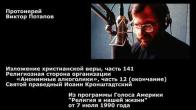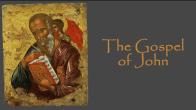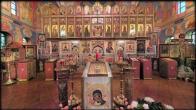You are here
Altar iconography
As a rule, Orthodox churches face Eastward, and in the eastern part of the church is the altar. In facing the altar, facing the direction from which the sun rises, man symbolizes his turning towards God, for Christ is the Sun of Truth.
We offer for your information a description of the iconographic decoration of our church.
The Vault
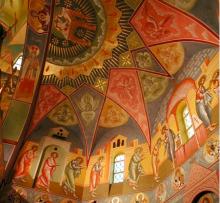 The altar vault is spherical, consisting of five sections intersected by two curved ribs. The resulting spherical triangles make up rays of a large star whose center is at the acme of the vault. The eastern section is divided by the colors of one of the rays into two parts. As a result, there are seven rays and six spaces within the sections. Within this star is a smaller, six-pointed star, with each point divided in two, within which is an even smaller one, with twelve points
The altar vault is spherical, consisting of five sections intersected by two curved ribs. The resulting spherical triangles make up rays of a large star whose center is at the acme of the vault. The eastern section is divided by the colors of one of the rays into two parts. As a result, there are seven rays and six spaces within the sections. Within this star is a smaller, six-pointed star, with each point divided in two, within which is an even smaller one, with twelve points
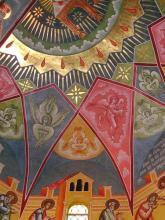 At the center of the vault, within concentric circles of the “heavenly spheres” is depicted the “Prepared Throne.” Above it is a symbolic representation of the Holy Spirit “in the form of a dove.” From the center to the twelve points of the interior star there are arranged twelve “tongues of fire,” a symbolic representation of the descent into the world of the Holy Spirit. The background, upon which the “tongues” are depicted, is gold, symbolizing the color of the Kingdom of God. The next circle of the twelve-pointed star is comprised of rays. Within six diamond shapes are stars. In seven rays of the great star are flaming Seraphim. The Seraphim are one of the highest ranks of angels, those closest to God. In icons they are represented with six wings: with two they cover their faces as unworthy of looking upon God; with two they cover their feet, as unworthy of being looked upon by God, and with two they fly to fulfill the heavenly commands. The Seraphim unceasingly chant the hymn “Holy, Holy, Holy, Lord of Sabaoth. Heaven and earth are full of Thy Glory!”
At the center of the vault, within concentric circles of the “heavenly spheres” is depicted the “Prepared Throne.” Above it is a symbolic representation of the Holy Spirit “in the form of a dove.” From the center to the twelve points of the interior star there are arranged twelve “tongues of fire,” a symbolic representation of the descent into the world of the Holy Spirit. The background, upon which the “tongues” are depicted, is gold, symbolizing the color of the Kingdom of God. The next circle of the twelve-pointed star is comprised of rays. Within six diamond shapes are stars. In seven rays of the great star are flaming Seraphim. The Seraphim are one of the highest ranks of angels, those closest to God. In icons they are represented with six wings: with two they cover their faces as unworthy of looking upon God; with two they cover their feet, as unworthy of being looked upon by God, and with two they fly to fulfill the heavenly commands. The Seraphim unceasingly chant the hymn “Holy, Holy, Holy, Lord of Sabaoth. Heaven and earth are full of Thy Glory!”
 In the spaces between the stars are monochromatic (terra verde) representations of the Cherubim, depicted in semi-circles of clouds. The Cherubim are the carriers of Divine Truth. They make up a special rank of angels, one of the highest in the Heavenly hierarchy, occupying second place in the nine ranks of angels. They are depicted as human faces within six wings.
In the spaces between the stars are monochromatic (terra verde) representations of the Cherubim, depicted in semi-circles of clouds. The Cherubim are the carriers of Divine Truth. They make up a special rank of angels, one of the highest in the Heavenly hierarchy, occupying second place in the nine ranks of angels. They are depicted as human faces within six wings.
Symbols of the Evangelists are also included in the composition of the vault. These are images of living beings which were incorporated into iconography and which are often depicted with the Evangelists. In our altar vault, the symbols of the Evangelists are depicted independently.
An angel corresponds to the Holy Evangelist Matthew as a symbol of the messianic mission to the world by the Son of God, as predicted by the prophets. The Evangelist Mark is depicted as a lion, in token of the power and kingship of Christ. The symbol of the Evangelist Luke, a calf, underscores the sacrificial, redemptive work of the Savior. The eagle, the symbol of the Evangelist John, signifies the loftiness of evangelic teaching and the Divine Mysteries proclaimed therein.
The Walls
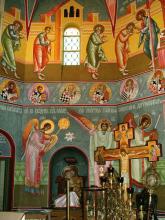 All five walls of our altar are considered to be one whole, and are not separated by vertical borders. Along the horizontal, they are divided into three levels. The uppermost level depicts the Eucharist, or Communion of the Apostles. Surrounding the window on the eastern wall is depicted a ciborium or baldachin (an altar canopy), so that the windowsill becomes the upper panel of the altar table. To the left, the Savior offers His Holy Body to the Holy Apostle Peter. The inscription reads: “Take eat….” On the right, the Lord communes St. Paul from the Holy Chalice. The inscription: “Drink of it all of you…” In the northeast and southeast panels are depicted two apostles (with a window between them), and in the northern and southern panels there are depicted three apostles each. By the way, the apostles at the center of these panels are depicted within shallow niches. The tops of these niches are incorporated as details of the composition.
All five walls of our altar are considered to be one whole, and are not separated by vertical borders. Along the horizontal, they are divided into three levels. The uppermost level depicts the Eucharist, or Communion of the Apostles. Surrounding the window on the eastern wall is depicted a ciborium or baldachin (an altar canopy), so that the windowsill becomes the upper panel of the altar table. To the left, the Savior offers His Holy Body to the Holy Apostle Peter. The inscription reads: “Take eat….” On the right, the Lord communes St. Paul from the Holy Chalice. The inscription: “Drink of it all of you…” In the northeast and southeast panels are depicted two apostles (with a window between them), and in the northern and southern panels there are depicted three apostles each. By the way, the apostles at the center of these panels are depicted within shallow niches. The tops of these niches are incorporated as details of the composition.
The middle level consists of an ornamental stripe containing circular medallions, four in the eastern panel, and three in each of the remaining panels, for a total of sixteen. On the altar crossbeam connecting the northern and southern walls of the church, there will be an additional eight medallions. In the middle level there are depicted the hierarchs for whom there is insufficient room in the lower level:
 James the brother of the Lord, Athanasius and Cyril of Alexandria, Gregory the Dialogist, Leo and Sylvester, popes of Rome, Dionysius the Areopagite, the Apostle Timothy, Tarasius of Constantinople, Gregory of Nyssa, Gregory Palamas, Spyridon of Tremithus, Andrew of Crete, Ignatius the Godbearer, Hypatius of Gangra, Parthenius of Lampasacus, Blaise of Sebaste, Acacius of Melitine, Ambrose of Mediolanum (Milan), and Miliy of Persia.
James the brother of the Lord, Athanasius and Cyril of Alexandria, Gregory the Dialogist, Leo and Sylvester, popes of Rome, Dionysius the Areopagite, the Apostle Timothy, Tarasius of Constantinople, Gregory of Nyssa, Gregory Palamas, Spyridon of Tremithus, Andrew of Crete, Ignatius the Godbearer, Hypatius of Gangra, Parthenius of Lampasacus, Blaise of Sebaste, Acacius of Melitine, Ambrose of Mediolanum (Milan), and Miliy of Persia.
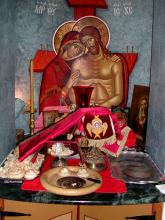 The lower level depicts the Divine Liturgy. The inscription “Now the powers of heaven…” is a hymn from the Liturgy of the Presanctified Gifts, celebrated during Great Lent. Within a niche on the eastern wall, directly opposite the altar table is the Savior, attired in bishop’s vestments, and standing behind an altar table depicted on the lower part of the niche. The arch of the niche is utilized as the front arch of the ciborium (of a different style than that used in the upper level). The top of this ciborium touches the middle level, while the Cross which crowns that level touches the upper level. To the left and right are two angels, in deacon’s vestments, bearing processional candles. On the northeast panel, next to the alcove of the Table of Prothesis, is depicted an angel in deacon’s vestments, holding a diskos (a round vessel on which the Holy Lamb, the Body of Christ, is blessed in the course of the Divine Liturgy.) On the opposite side of the alcove is an angel in deacon’s vestments, holding a ripida, a type of fan mounted on a long staff. On the ripida is depicted a six-winged cherub. During divine services, the ripidi, symbolizing the wings of angels, are held above the Holy Gifts or above the Gospel when it is being read. On the southeast panel of the altar is an angel in priest’s vestments, holding a chalice (cup) in his hands. On the other side of the alcove is another angel with a ripida. On the southern panel, above the door to the southern panomarka or vestry (a room in which liturgical plate and priestly vestments are stored), is a waist-length depiction of the Holy Hierarch Hierothius, bishop of Athens. To the east of the door is St. Basil the Great, and to the west, St. Gregory the Theologian.
The lower level depicts the Divine Liturgy. The inscription “Now the powers of heaven…” is a hymn from the Liturgy of the Presanctified Gifts, celebrated during Great Lent. Within a niche on the eastern wall, directly opposite the altar table is the Savior, attired in bishop’s vestments, and standing behind an altar table depicted on the lower part of the niche. The arch of the niche is utilized as the front arch of the ciborium (of a different style than that used in the upper level). The top of this ciborium touches the middle level, while the Cross which crowns that level touches the upper level. To the left and right are two angels, in deacon’s vestments, bearing processional candles. On the northeast panel, next to the alcove of the Table of Prothesis, is depicted an angel in deacon’s vestments, holding a diskos (a round vessel on which the Holy Lamb, the Body of Christ, is blessed in the course of the Divine Liturgy.) On the opposite side of the alcove is an angel in deacon’s vestments, holding a ripida, a type of fan mounted on a long staff. On the ripida is depicted a six-winged cherub. During divine services, the ripidi, symbolizing the wings of angels, are held above the Holy Gifts or above the Gospel when it is being read. On the southeast panel of the altar is an angel in priest’s vestments, holding a chalice (cup) in his hands. On the other side of the alcove is another angel with a ripida. On the southern panel, above the door to the southern panomarka or vestry (a room in which liturgical plate and priestly vestments are stored), is a waist-length depiction of the Holy Hierarch Hierothius, bishop of Athens. To the east of the door is St. Basil the Great, and to the west, St. Gregory the Theologian.
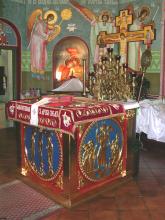 In the alcove behind the Table of Prothesis, the place where during the proskomedia the coming Eucharistic sacrifice is prepared, is a depiction of the icon “Do not weep for Me Mother.” In this touching icon Christ is depicted, standing up to the waist in the tomb. Behind him is the Cross, bearing the inscription “King of Glory.” The Mother of God, who seems to be supporting Him, is also depicted to the waist, with her head inclined towards His right shoulder. This image illustrates one of the irmoi of the canon for Great Saturday; “Do not weep for Me Mother, seeing Me in the tomb, the Son whom thou didst conceive in the womb without seed. For I shall arise, and shall be glorified, and shall be raised up with Glory, ever as God, with faith and love magnifying Thee.
In the alcove behind the Table of Prothesis, the place where during the proskomedia the coming Eucharistic sacrifice is prepared, is a depiction of the icon “Do not weep for Me Mother.” In this touching icon Christ is depicted, standing up to the waist in the tomb. Behind him is the Cross, bearing the inscription “King of Glory.” The Mother of God, who seems to be supporting Him, is also depicted to the waist, with her head inclined towards His right shoulder. This image illustrates one of the irmoi of the canon for Great Saturday; “Do not weep for Me Mother, seeing Me in the tomb, the Son whom thou didst conceive in the womb without seed. For I shall arise, and shall be glorified, and shall be raised up with Glory, ever as God, with faith and love magnifying Thee.
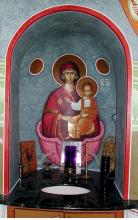 In the southern alcove is an icon of the “Life-giving Spring” Mother of God. This icon depicts the Mother of God with the Child in her arms, seated in a large chalice from which flow streams of water. According to tradition, the first such icon was written to commemorate the miraculous healing wrought by the waters of this fountain of the Byzantine Emperor Leo I during the middle of the 5th century.
In the southern alcove is an icon of the “Life-giving Spring” Mother of God. This icon depicts the Mother of God with the Child in her arms, seated in a large chalice from which flow streams of water. According to tradition, the first such icon was written to commemorate the miraculous healing wrought by the waters of this fountain of the Byzantine Emperor Leo I during the middle of the 5th century.
Above the door to the northern vestry is depicted St. Nicholas the Wonderworker. To the west of the door is depicted St. John Chrysostom.
Occupying the central place in the Altar is the Holy Table, which represents the Throne of God, with the Lord Himself invisibly present there. It also represents the Tomb of Christ, since His Body (the Holy Gifts) is placed there.
The Holy Table is square in shape and is draped by two coverings. The first, inner covering, is of white linen, representing the winding-sheet in which the Body of Christ was wrapped. The outer cloth is made of rich and bright material, representing the glory of God s throne. Both cloths cover the Holy Table to the ground.
PARISH LIFE
RECENT VIDEOS
Address of our Cathedral
Subscribe to our mailing list
While all the materials on this site are copyrighted, you may use them freely as long as you treat them
with respect and provide attribution on the Russian Orthodox Cathedral of St.John the Baptist of Washington DC.



